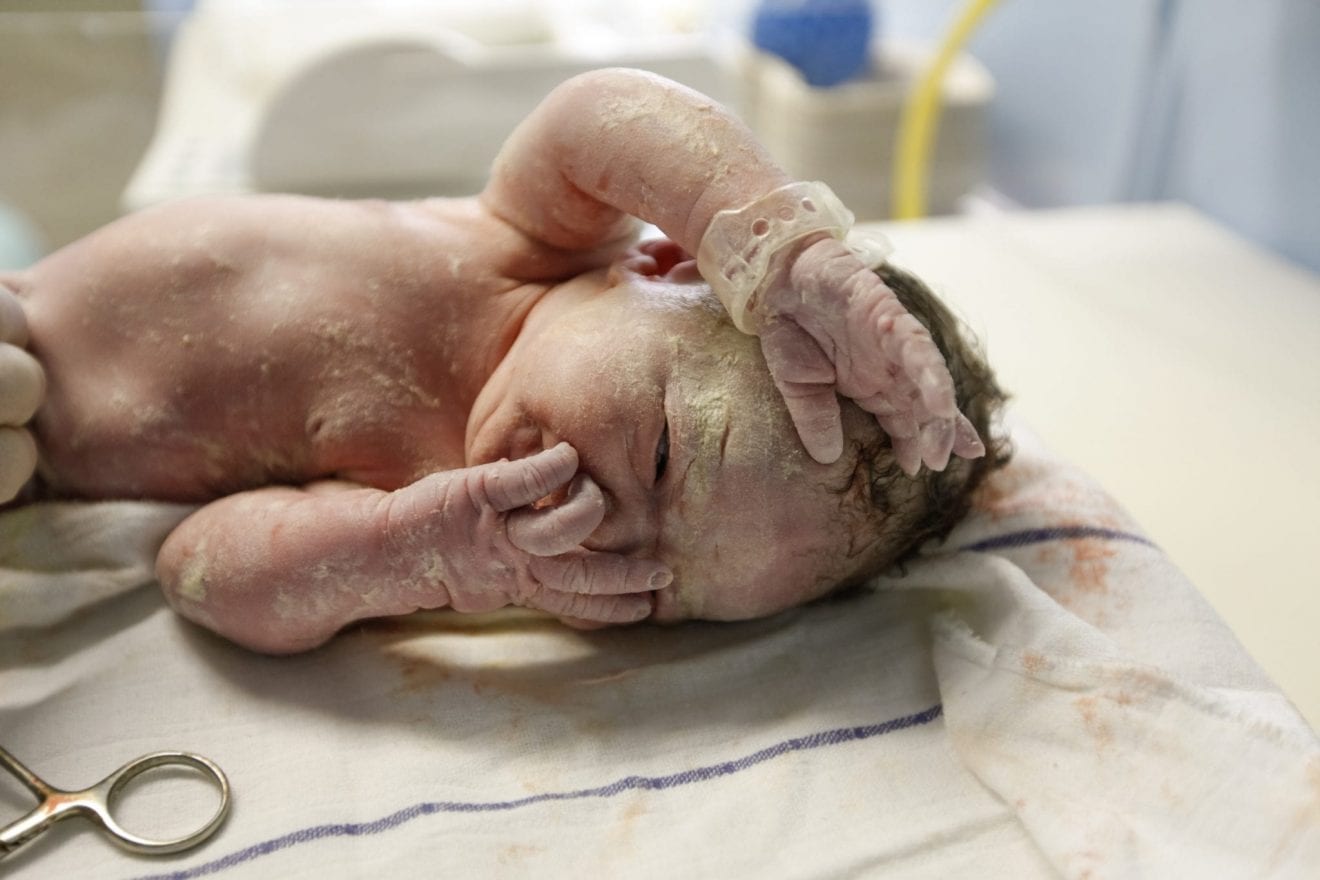From mucus plugs to amniotic fluid, blood loss during delivery to urinary catheters, birth can be a messy endeavor among bodily fluids you might not even be familiar with. As much as you cannot help but kiss your newborn, their skin may not appear perfectly pink and squeaky clean immediately after birth. One substance that may be present on your newborn is vernix caseosa. And while it may not seem the most hygienic, it has many beneficial properties for you and your baby.
Maybe you have seen photos of a newborn coated in a white covering, or maybe your baby had it, and you wondered what it was. Or perhaps you are completely unfamiliar with this substance. As you prepare to deliver, you may be curious about vernix, its function, and what to do with it on your baby’s skin.
What Is Vernix Caseosa?
Translated literally from Latin, vernix means “varnish,” and caseosa means “cheese.”1 This cream-cheese-like substance can be found coating the skin of some newborns at birth. In other babies, it can be found only in skin folds and creases such as the armpits. You may also not notice any at all.2
What Does Vernix Look Like?
Vernix typically appears like a thick white covering or cream, like lotion, that has not been rubbed into the skin.2
Very premature babies may have less vernix visible on their skin because not much has been produced yet. Slightly premature babies often have the highest concentration because it is at its peak production and has not begun sloughing off into the amniotic fluid.2
Overdue babies may have a yellowish coating. They are also more likely to have no coating left, as it has all been washed into the amniotic fluid by the time they are born.2
Vernix can have a different appearance if the baby has a blood disorder or has experienced fetal distress. If newborns have their first bowel movement (meconium) before birth, their coating could appear stained green or black.2
When Does Vernix Develop?
It begins around the middle of the second trimester and peaks in the third. It remains on the skin of the baby until birth.2
What Is Vernix Made Of?
It is made primarily of water but contains fats and proteins essential for moisturizing and germ-fighting functions. Interestingly, the exact composition varies depending on gestational age, sex of the fetus, and even factors like maternal medications and lifestyle.1
What Does Vernix Do and Why Is It Important?
Vernix has many functions during pregnancy, delivery, and even in the first week of a newborn’s life.
- Waterproofing: In utero, vernix waterproofs the baby’s skin so it does not wrinkle and swell like adult human skin.2
- Barrier: Vernix acts as a barrier between the mother’s vagina and the baby, thereby protecting the baby’s skin from any pathogens present in the vagina.1 Its barrier properties also help protect the baby against losing too much water through evaporation once exposed to air.3
- Lubrication: Vernix can act as a vaginal lubricant during delivery, helping the baby progress more smoothly through the birth canal.1
- Immunity: Some proteins in vernix help a baby fight off potential infections and even kill certain germs.1 It may also assist in intestinal development and the gut microbiome.3
- Skin benefits: Vernix helps hydrate the skin and can accelerate wound healing. Its wound-healing properties apply to mom, too. If you experience perineal tearing from birth, your baby’s vernix may help you heal.2
- Temperature regulation: It is thought that vernix helps keep newborn babies warm by preventing heat loss before their first bath.3
Should You Leave Vernix on a Baby?
For years, the standard practice for nurses was to dry a newborn immediately and wipe all residue from their skin after birth. This drying and stimulating action was thought to encourage them to take their first breaths. Some people also viewed unbathed babies as unhygienic, so for decades, it was often removed by default. The practice of removing vernix is slowly changing as research, studies, and recommendations continue to demonstrate the benefits of leaving it in place.2
Research has shown that newborns whose vernix was left on had more well-hydrated skin.4 It has a higher water content than over-the-counter barrier creams, which may better moisturize the skin. Vernix also acidifies the skin’s surface, which helps fight off bacteria looking to multiply on the skin’s surface.2 Besides adjusting the pH of your baby’s skin, vernix acts as a barrier or “second skin,” directly blocking germs and fighting them off.2
As a parent, it is your choice whether you decide to leave the vernix on your baby, but it may be beneficial to leave it. If left alone, it will naturally dissipate from the skin by around five days after birth, but it may remain in the creases for up to 10 days.2
The only time it may make sense to bathe your baby soon after birth for hygiene purposes is if they are stained with meconium or the baby’s first poop. If you would like to leave vernix on your baby’s skin, be sure to write this in your birth plan and communicate this wish in the delivery room so it does not get wiped away inadvertently. Also, be sure to mention that you would like to delay your baby’s first bath.5
Is It Okay if My Baby Is Born Without Vernix?
While there are many benefits to vernix caseosa, and it is usually best to leave it in place after birth, there is no cause for concern if you cannot see any on your baby.
The thickest vernix coating is usually found between 36 and 38 weeks of gestation. If your baby was born much before or after that, you may have missed their “peak” coating.5 If your baby was extremely preterm, theirs may not have yet been produced in significant quantities. If pregnancy continues beyond 36 to 38 weeks, vernix detaches from the baby’s skin and dissolves into the amniotic fluid. This makes full-term amniotic fluid whiter and less clear than earlier fluid.2
Finally, if none of these criteria explain your baby’s lack of vernix, it could have been mostly wiped off during the birth process. You can likely find remnants if you check your baby’s skin folds. But there are many reasons why you may not see any on your baby, and they still reap its benefits even if you cannot see evidence of it.
While cleaning your new baby before snuggling them may be tempting, vernix on your baby is designed to help them adjust to the outside world over the first few days of life. Try to leave it alone or rub it into their skin. It will be gone before you know it.















